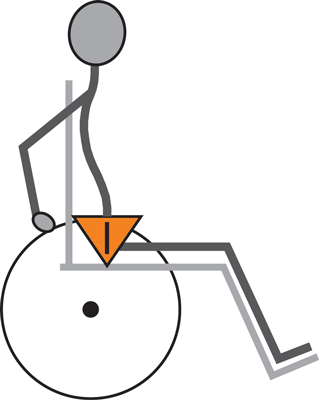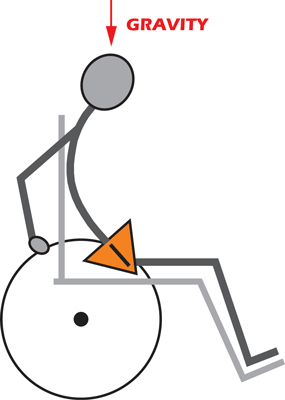Take it offline!
This Education in Motion resource is also available as a printable PDF.
Download PDF
.jpg.aspx?lang=en-CA)
Provides changes in position for clients who cannot weight shift independently.
When individuals are unable to weight shift independently, or change positions while seated upright, they are at high risk for pressure injuries. Sitting tolerance also is compromised due to the inability to redistribute pressure.
Manual wheelchairs with tilt:
- Provide a means for weight shifts and position changes.
- Reduce the risk of pressure injury by redistributing pressure from the pelvis to the trunk.
- Provide a safe and easy way for assistants to provide weight shifts for occupants.
To be effective for pressure relief at the ischial tuberosities, the angle of tilt must be greater than 25 degrees. Repositioning should occur for at least one to two minutes every 30 minutes.
Provides changes in position for clients who cannot maintain pelvic, thoracic, or head position and/or balance against gravity for prolonged periods of time.
- While sitting in the upright position, gravity pushes down on the body.
- If muscle strength or overall endurance is compromised, clients will be unable to maintain proper upright posture, which can lead to postural deviations such as a posterior pelvic tilt, thoracic kyphosis, and/or lateral lean.
- Tilt helps promote proper seating alignment and decreases potential for postural deviations.

Upright posture is maintained against gravity in standard back

Poor posture results when fatigue occurs over time
- Increased risk for non-correctable orthopedic deviations and pressure injury on the sacrum and spine results from poor posture over time.
- Tilting clients when they fatigue helps maintain them in an upright position, facilitates thoracic extension, and a neutral pelvis.
Tilt reorients the body in space to reduce the effects of gravity and promote neutral posture.
Provides appropriate position for clients who are at risk for respiratory complications.
If clients cannot maintain upright posture and fall into poor posture, as above, the respiratory system can become compromised.
- The diaphragm has less room to drop as it contracts, so lungs do not fully expand.
- Can result in the collapse of lower parts of the lung (atelectasis).
- Secretions are not mobilized - can result in pneumonia.
- It becomes more difficult to take a deep breath.
- Breathing is shallower and therefore faster.
- Tilt can often be used to promote thoracic extension and reduce the risk of respiratory complications.
Provides appropriate position for clients who are at risk for digestive complications.
If clients cannot maintain upright posture and slide into poor posture, the digestive system can become compromised.
- Food cannot pass as easily down the gastrointestinal tract - this can result in gastritis, gastric reflux, esophagitis, and/or bowel impaction.
- Head and neck position are not optimal.
- Can cause aspiration with swallowing.
- Can set off primitive reflexes such as the gag reflex or tongue thrust.
- Tilt can be used to promote postures that reduce risk of the gastrointestinal complications.
Provides appropriate position for clients who are at risk for postural hypotension.
A condition in which the blood pressure drops when client is in the upright position.
- Could lead to dizziness or loss of consciousness - a potentially dangerous event.
- Tilt can encourage blood flow above the level of the heart to assist if this condition were to occur.
Provides appropriate position for clients who are at risk for autonomic dysreflexia.
A condition in which the blood pressure increases due to an event or condition that the body interprets as "noxious".
- This is a potentially life threatening warning sign produced by the body to let individuals with spinal cord injuries know that something is wrong.
- Could be caused by an overfull bladder (kinked catheter), an impacted bowel, a constriction of blood flow, a change in position, etc.
- Tilt allows clients to be brought quickly into the most upright position to try to assist in lowering blood pressure.
Provides a change in position while minimizing the risk of extensor spasticity.
- A slight opening of the hip angle at the beginning of a weight shift can sometimes cause an extensor spasm.
- Tilt maintains the optimal hip angle throughout the weight shift.
Provides a change in position without the risk of shear forces.
QUICKIE IRIS®
The mechanism of tilt on the QUICKIE IRIS® has a curved rocker-arm that allows the seat frame to rotate on the base frame, while maintaining an individual's center of gravity (COG) in near perfect alignment with the chair's center of rotation (COR). This alignment is maintained throughout the tilt away and return-to-upright cycle. Since the individual's COG remains constant, and there is virtually no horizontal displacement in COG as seen in other tilt mechanisms, the IRIS has the following advantages over other tilt systems:
- Can use the shortest wheelbase on the market without compromise to the mobility base stability. This can significantly increase maneuverability for the operator.
- COG and COR alignment significantly reduces potential of front-loading the casters without compromising maneuverability or safety for the assistant or client.
- With the occupant's COG and the wheelchair's COR in optimal alignment, the amount of effort it can take an assistant to tilt the chair and bring back to upright position is drastically reduced allowing for smooth and effortless activity.
- A constant COG has the potential to eliminate the problems associated with the horizontal shift that occurs in other tilt systems, such as:
- Triggers or disturbances that could result in spasticity.
- Agitation in clients with cognitive issues.
- Protective extension reactions.
Clinical Support Information Citations
- Consortium for Spinal Cord Medicine, Pressure Ulcer Prevention and Treatment Following Spinal Cord Injury: A clinical guideline for Health-Care Professionals 2nd. ed., 2014.
- Dicianno, B. E., Lieberman, J., Schmeler, M. R., Souza, A. E., Cooper, R., Lange, M.,...Jan, Y. (2015). Rehabilitation Engineering and Assistive Technology Society of North America's Position on the Application of Tilt, Recline, and Elevating Legrests for Wheelchairs Literature Update. Assistive Technology,27(3), 193-198.
- Jan, Y., Liao, F., Jones, M. A., Rice, L. A., & Tisdell, T. (2013). Effects of Durations of Wheelchair Tilt-in-Space and Recline on Skin Perfusion Over the Ischial Tuberosity in People With Spinal Cord Injury. Archives of Physical Medicine and Rehabilitation,94(4), 667-672.